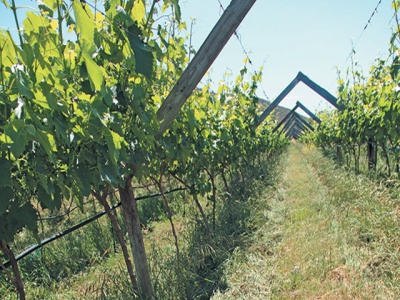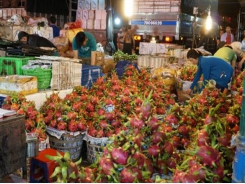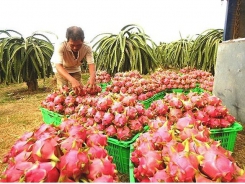Biological wine farmer achieves twice regional average yield

Seven years ago, Fritz Breytenbach, a wine grape producer in the Robertson Valley, embarked on his biological farming journey. Today, he is reaping the benefits by producing almost double the regional production average using the same inputs as neighbouring farmers.
Weeds are cut down with a mulcher up to six times a year. The cuttings are thrown into the plant rows by the mulchers. Photo: Glenneis Kriel
Many consultants and farmers dismiss the idea of “farming with nature” as pie in the sky, arguing that the omission of chemical fertilisers and pesticides has a negative impact on production and renders a farm unprofitable over time.
However, Fritz Breytenbach, who applies biological farming methods to his wine grape production and canning fruit business in the Western Cape, has experienced the opposite: his production volumes have increased, while his input costs have come down.
Sterik de Wet, CEO of Ashton Winery, confirmed this: “The quality of Fritz’s wine grapes is so outstanding that they sell as soon as they hit the barrel, in spite of tight market conditions. He has also been among our top five producers in terms of wine grape quality and income per hectare for the past five years.” (See Tables 1 and 2)

Fritz, who farms on Middelplaas and Wakkerstroom in the Robertson Valley, says that the overuse of herbicides results in poor soil condition and has a negative impact on the soil’s humus content.
“My decision to use fewer chemicals is rooted in the impact these products have on the humus content of the soil. Just a 1% increase in the organic content of your soil could result in the soil holding 170 000ℓ more water per hectare. This is especially important in light of climate change and the predicted impact this will have on farming in the future.

“When I look at other farmers’ vineyards and orchards, their soils look like cement slabs to me. Unless they’re using cover crops, there’s nothing to buffer soil temperatures.”
Oxygenated water
Fritz’s biological farming journey started seven years ago, with the installation of Puricare’s Soilcare unit in his micro-sprinkler system. The unit produces activated oxygen, which is pumped into the irrigation water.
“The manufacturers persuaded me to use the unit for trial purposes. The results were quite unexpected,” he recalls.
Whereas average production amongst Ashton Winery producers in the region decreased 19% in 2010, average production at Middelplaas increased between 8% and 41%. Vines and trees also seemed healthier.
“Trees and vines that I’d written off to disease, pest problems and old age actually started producing viable crops again,” Fritz says
He explains that oxygenated water helps to soften and improve irrigation water quality by destroying pathogens, while reducing salts and oxidising metal pollutants in the water.
“This is a great benefit in the Robertson Valley, where most farmers have to deal with brackish water during the winter months. Last winter, dry conditions made the water so saline that it was unsuitable for commercial production.”
Oxygenated water can also increase water infiltration rates, reduce soil compaction, lower soil water pH, increase electrolyte concentrations and accelerate biological degradation of organic matter.
“Puricare claimed that the activated oxygen would help to unlock soil nutrients that were previously unavailable to plants. To test this, I stopped fertilising the orchards and vineyards. I also stopped planting cover crops, allowing weeds to serve this purpose.”
The result was a marked improvement in soil structure. Softer natural grasses, such as ryegrass and rescue grass, displaced broadleaf weeds such as tall fleabane, narrowleaf ribwort and burweed. Fritz was so satisfied with the outcome that he installed a Puricare unit on his other farm, Wakkerstroom.
To better understand these results and take production to the next level, Fritz turned to books written by the great biological production gurus, including Gary Zimmer’s The Biological Farmer, Neal Kinsey’s Hands-on Agronomy, Graeme Sait’s Nutrition Rules and Charles Walters’s Weeds: Control Without Poisons.
Hans Ellis, executive director at Cumgro, became Fritz’s production advisor, and Fritz asked him to read all these books to ensure that they shared and understood the same approach to production.
“The books made me realise that I needed to focus more on soil health if I wanted to produce healthy plants. You need to feed the soil to feed the plant,” Fritz says.
Albtrecht system
He started using the Albrecht system to analyse and monitor soil nutrient levels. According to this system, certain major elements must be present in the soil in a particular ratio. And since soil can contain only a certain amount of nutrients, an excess of one nutrient will result in the deficiency of another.
Saline water used on the farm has resulted in soil with high sodium and magnesium levels. Fritz uses gypsum, with 20% calcium and 17% sulphur, to strip the soil of excess cations. He warns, however, that gypsum should only be used if there is about 60% calcium, according to the Albrecht soil analysis, otherwise excess cations cannot leach out of the soil.
Soil samples taken in 2013 revealed that Fritz’s soil pH became more uniform, while calcium levels increased to more acceptable levels.
“Calcium is very important, as it helps to open up the soil and, in effect, enhance soil aeration,” he explains.
Feeding the soil
Various organic products are used to improve soil health and the soil’s nutrient status.
“I wanted to use compost, but it didn’t make economic sense to produce it myself or buy it in. Instead, I started using poultry manure on every second row to boost potassium and phosphate percentages,” says Fritz.
Humates, composed of various forms of carbon, are also used. Humic acid is applied via irrigation every second week. According to Hans, humic acid helps to unlock certain elements, such as potassium and nitrogen complexes, making the soil less volatile and prone to leaching.
“Humic acid also binds to clay particles and form complexes that can hold up to 16 times more minerals than clay, thereby enhancing the soil’s cation exchange capacity,” Hans says.
Soils with phosphate shortages are given rock phosphates in addition to humic acid.
Nitrogen is supplied via Vita NS40 and ammonium sulphate.
“Farmers should stop buying cheap nitrogen sources, as more than half of the nitrogen in these sources tend to leach out,” Fritz says.
Fritz addresses plant shortages through foliar feeds, and says that before starting this practice, he used to experience a production ceiling with his vines and trees. He also sprays boron and calcium, along with the required trace elements, in early spring to boost fruit set, and applies fulvic acid to address shortages.
Hans explains that plants are unable to absorb humic acid, as its molecules are too large. Fulvic acid, with its small molecules, can carry minerals, even those that are immobile such as calcium, magnesium and iron, from plant surfaces into plant tissues. Fulvic acid also stimulates oxygen uptake, making plants more heat- and drought-resistant.
Fritz adds that fulvic acid is a fungal stimulant, whereas humic acid is a bacterial stimulant.
He also uses Karabos products, which contain beneficial organisms, to boost soil life and suppress harmful organisms such as snails and nematodes.
Nematodes have been absent for seven years; it is only recently that they have begun to appear again.
“Instead of using harmful chemicals to get rid of the pathogenic nematodes, I’ll boost the levels of bacteria that feed on them to get the population balance back in check. I’ll obviously have to do this every few years, as the population balance is bound to be disturbed because of farming practices over time,” he says.
Weed management
Fritz initially struggled with weed management when he decided to use weeds as cover crops. Now weeds are controlled by cutting them down with a mulcher.
“The drawback is more tractor hours, as I use the mulcher up to six times a year to manage the weeds. On the positive side, using weed as a cover crop is much cheaper than planting a cover crop and you use fewer herbicides,” he says.
Cut plant material remains in plant rows. Whereas plastic sheets were used to keep the weeds out of the plant rows in the past, weeds are now allowed to grow inside plant rows. “It’s too labour-intensive to remove them and they don’t have a negative impact on production anyway.”
While Fritz tries to use as few herbicides as possible, he still uses Roundup to keep kikuyu and couch grass under control.
“These weeds are a problem. You need to take action before they get out of control.” Fritz says that switching to biological farming methods was a lonely journey, but seeing the improvement in soil structure, soil health and production has helped make up for this.
“The soil’s carbon content has increased from 0,07 parts per million to 0,81 parts per million over the past seven years, while in 2015 the white grape harvest was 64,34% better than in 2014, and 30,22% better than in 2013. Production volumes in vineyards older than 20 years increased from 14% to 44%. The farm achieved the highest gross income at Ashton Winery – more than R75 000/ha – out of 59 farms.
“One can still make a living from traditional commercial production practices, but for how long will chemical fertiliser and pesticides be economically viable? If you continue to use herbicides, you’ll sit with the same problems 10 years from now, but with poorer results.”
Related news
Tools

Phối trộn thức ăn chăn nuôi

Pha dung dịch thủy canh

Định mức cho tôm ăn

Phối trộn phân bón NPK

Xác định tỷ lệ tôm sống

Chuyển đổi đơn vị phân bón

Xác định công suất sục khí

Chuyển đổi đơn vị tôm

Tính diện tích nhà kính

Tính thể tích ao




 Rice farmers switch to corn as fresh water…
Rice farmers switch to corn as fresh water…  Tea industry needs to focus on quality
Tea industry needs to focus on quality